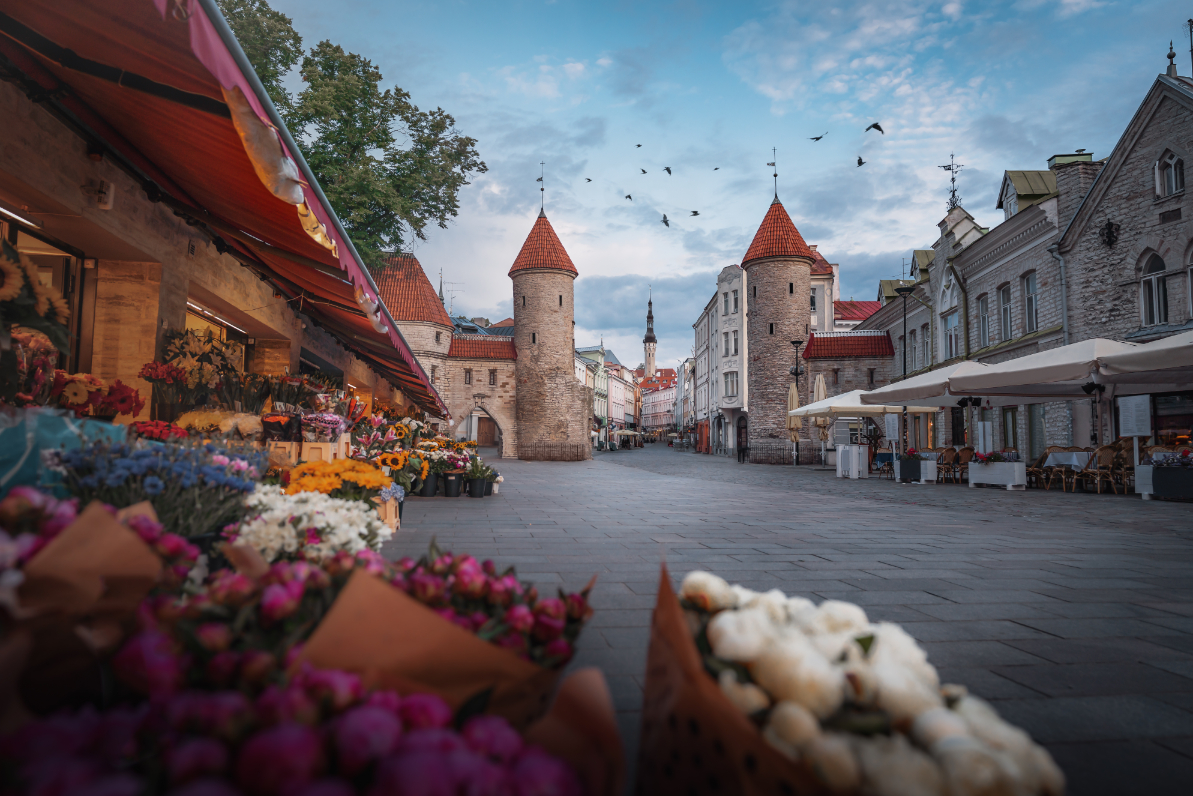Tallinn,
the capital of Estonia is one of the most beautiful cities in Europe. The historic center, declared a World Heritage Site in 1997, is an absolute delight. Its walls, towers, old houses, and narrow streets look like medieval decoration. Even its restaurants and shops have gone to great lengths to achieve that typical medieval look. In this practical post, we will try to summarize the must-see places in Tallinn.
Town Hall Square
Raekoja plats (Town Hall Square) is located in the heart of the medieval city of Tallinn and is usually a place with a lot of life. It regularly hosts a market for handicrafts, souvenirs, and local products, and concerts or large events are frequently held. The main tourist attraction of the square, without a doubt, is the imposing Town Hall, built in the Gothic style in 1404. It is easily recognizable by its 64m tower, similar to an Arab minaret. At the top is the Vana Toomas (soldier Thomas), placed in 1530 and a symbol of the city since then (although the current one is a copy). The interior of the Town Hall is open to tourists from the end of June to the end of August. Large meeting rooms with vaulted ceilings, the attic, and various “treasures” of the city are visited. From the windows, you have good views of the square (although you do not climb the tower). Another prominent place in the square is the Raeapteek, the City Hall pharmacy. It is one of the oldest pharmacies in the world. Its inauguration date is usually around 1422.
Tallinn ramparts
If the city of Tallinn is known for something, it is for its beautiful walls. Although partially rebuilt, today 20 towers, two gates, and about 2km of the wall remain. The original wooden fortification dated from the end of the 13th century, but the current stone wall began to be built in the 14th century. In addition to walking around the outer or inner perimeter at your own leisure, there are several points of interest that we would like to recommend. The section of the wall that can be covered on foot (indicated by the generic name of Tallinna Linnamüür) is the one that connects the towers of Nunna, Sauna, and Kuldjala. We could not go because of the schedules, but we got rid of the thorn walking through the terrace of the Dannebrog cafe, located on the wall itself. This cafe is located in the Gardens of the Danish King, an ideal place to enjoy the fortification. Nor should you miss the two doors that are still standing. The most spectacular is the Viru Gate, of which two of the towers that formed it still conserve. At the end of Pikk Street, one of the most beautiful in Tallinn is the Great Coastal Gate, attached to the Paks Margaretta tower.
Kadriorg Palace and Park
If you have at least two days to visit Tallinn, we suggest you go to the Kadriorg Palace. This colorful Baroque palace, built by order of the Russian Tsar Peter the Great in 1718, today houses an art museum. Even if you are not interested in visiting the collection, it is worth going there to enjoy the beautiful palace gardens and the entire surroundings of Kadriorg Park, full of fountains, small lakes, trees, and various period buildings, as well as the open-air amphitheater free Lauluväljak. If you want to complete your visit to the area, you can go to the modern Kumu art museum, awarded in 2008 with the “European Museum of the Year” award. In the area, we could also see several wooden houses in traditional Estonian style.
Lahemaa National Park (Estonia)
Lahemaa National Park, one of the best places to see near Tallinn. Located about 70 km from the Estonian capital, this beautiful natural environment offers many possibilities to visitors, but it is especially known for its picturesque paths between forests and swamps. In this post, we tell you everything you need to visit Lahemaa National Park.
Lahemaa occupies an area of 725 km² and is located about 70 km east of Tallinn, between the E20 motorway and the Gulf of Finland. In 1971 it was declared a National Park, then becoming the first in the entire Soviet Union. More than 70% of its surface is covered by forests and within the park, there are also seven rivers, dozens of swamps, and a long maritime strip. Among the fauna present, the wild boars, elk, wolves, bears, and lynx stand out.
What to see in Lahemaa National Park The main reason to go to Lahemaa is its network of trails, with more than 20 routes totaling 120 km. It is also a land of culture and traditions; you can visit some old settlements, historic wooden houses, and four stately mansions. Viru Bog Nature Trail If you can only spend a few hours visiting Lahemaa, we suggest you go directly to the beginning of the “Viru Bog” (Viru Raba in Estonian) trail, probably the best known and most spectacular in the park. It is a circular route of about 6 km in length with an area of 3.5 km of wooden walkways that meander between small swamps. The path is flat and simple, so 3 hours would be more than enough to cover it.
From the parking lot (all the locations at the end of the post) you will walk a little over 500 m through pine forests before reaching the swampy area, where the wooden walkway begins. During the route, you will find some posters translated into English informing about fauna and vegetation. There are two places of interest: the observation tower, located 1.7 km from the beginning (perfect viewpoint), and a bathing area that is located shortly after.
Saaremaa Island (Estonia)
If you are considering a trip to the Baltic States (Lithuania, Latvia, and Estonia), one of the places you should consider is the island of Saaremaa, in western Estonia. Although it is a huge island, the population density is very low, the roads have little traffic and the towns are really quiet. It is a very pleasant place to spend 2 or 3 days of relaxation visiting mills, small villages and some curious places, such as the crater where a large meteorite struck.
Saaremaa, located in the Baltic Sea, is the largest island in Estonia and one of the 4 inhabited islands of the Moonsund Archipelago, where there are more than 500. It is located just north of the Gulf of Riga and about 200km southwest of Tallinn. Just over 30,000 people live in Saaremaa, half of whom reside in Kuressaare, the capital. It is a very flat island (the highest point reaches 54m), wooded, and with long two-way roads that connect the main points. In general, it is easy and comfortable to navigate by car and, in this sense, Kuressaare is a good option as a “base of operations”. We will talk about how to get there and other practical details at the end of the post. Finally, before starting with the featured visits, we encourage you to read about the history of the island and of Estonia in general. Vikings, Livonians, Swedes, Danes, Russians, Nazis, Communists … it’s a full-blown Game of Thrones.
Kuressaare Castle (and Saaremaa Museum) .Kuressaare Castle is undoubtedly the island’s great tourist attraction and, surely, the reason why many people decide to visit it. It is a historic fortification from the late 14th century built by the Teutonic Order in their efforts to Christianize the ancient region of Livonia. The exterior spaces, even inside the fortification, are freely accessible, but the entrance is paid to visit the interior, which houses the magnificent Museum of Saaremaa. The town of Kuressaare is not of great beauty, but it is very quiet and with several traditional buildings, a large park, and a small beach that justify a good walk and make the stay very pleasant.


Comment (0)